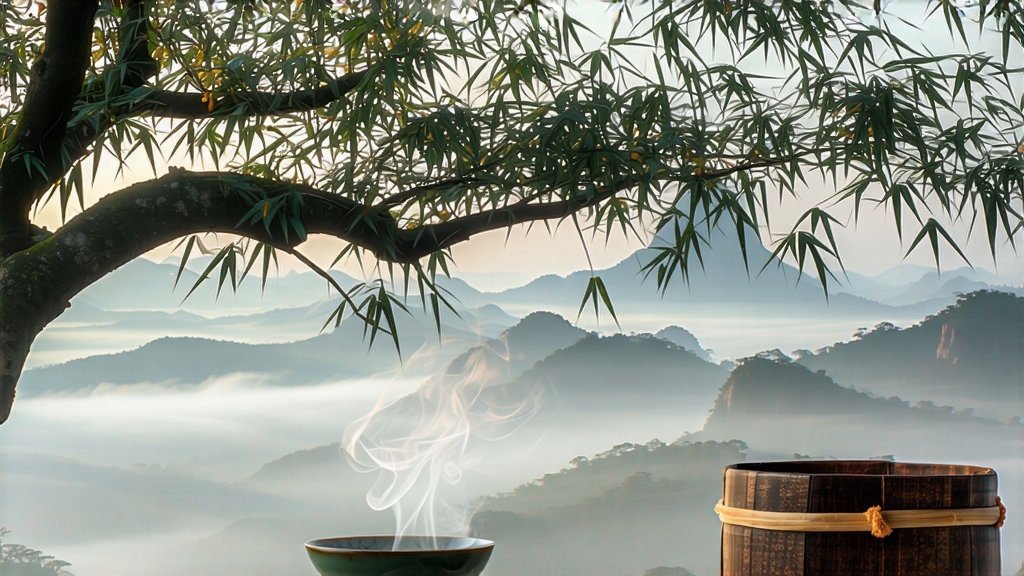
Tucked above the perpetual cloud belt of Sichuan’s Mt. Meng, Meng Ding Huang Ya has been quietly perfecting its golden hue for twelve centuries. Foreign catalogues often relegate yellow tea to a footnote between green and oolong, yet this single-bud style once travelled the Min River in sealed bamboo tubes to greet Tang-dynasty emperors, its soft yellow liquor praised by poet-monks as “liquid sunrise.” Today only 280 mu of pre-war bushes survive on the mist-shrouded plateau, making each spring harvest more time capsule than commodity. Understanding Meng Ding Huang Ya is therefore a rescue mission: every leaf tells the story of how Chinese artisans learned to “smother” vitality just enough to mellow edges without erasing soul.
History: A Chronicle in Gold
The first written record appears in 808 CE, when Chancellor Li Deyu listed “Meng Mountain Yellow Sprout” among the ten tribute teas worthy of imperial tax. Song-era tea officer Zhao Ru-liang noted its “three-yellow” trait—dry leaf, wet leaf, and liquor all carrying a buttercup glow—while Ming gourmets valued the ability to age gracefully, comparing decade-old cakes to aged white wine. When green tea fever swept China in the 1980s, yellowing kilns were dismantled; by 1998 annual output dipped below 300 kg. A small group of state craftsmen revived the technique in 2006, using 1,200-year-old mother trees on the “Royal Five-Peak” plot as genetic bank. The tea is now geopark-protected and sold by pre-order, yet remains virtually unknown outside Asia.
Micro-Terroir: Where Clouds Polish Chemistry
Mt. Meng’s summit, 1,456 m above sea level, traps a 89 % average humidity that forces buds to synthesize extra theanine. Diurnal swings of 12 °C slow polyphenol oxidation, while 4.5 pH sandstone soil delivers rare-earth ions that later catalyze the yellowing reaction. Farmers insist the leaf must be picked when mountain mist is so thick that “you can squeeze water from air,” because surface moisture acts as a natural buffer against mechanical bruising. The result is a bud set containing 5.8 % amino acids—almost twice that of neighboring green teas—yet only 8 % catechins, explaining the famously soft finish.
Plucking Code: One Bud, One Dawn
Harvest opens on the first cicada call, usually between 20 March and 5 April. Only the apical bud plus half-open first leaf, still cloaked in silvery down, qualifies. Pickers wear cotton gloves to prevent fingerprint oils from blocking yellowing enzymes; bamboo baskets lined with fresh banana leaves keep the temperature below 25 °C during the 3-hour downhill trek. A master can pluck 600 g fresh material per hour, but 5 kg are needed for 1 kg finished tea, translating into 15,000 hand movements per kilo.
Craft: The Secret Smothering
Meng Ding Huang Ya is not merely “green tea with a sauna.” After a 30-second 160 °C wok kill-green, the buds are immediately wrapped in thick hemp cloth and placed inside a bamboo steam chamber at 38 °C and 75 % humidity for 70 minutes. This “men huang” (sealed yellowing) phase allows residual enzymes to convert chlorophyll into pheophytin while oxidizing flavonols into golden polymers. Artisans listen for a faint popcorn note—an auditory cue that the leaf core has reached 55 °C—then unwrap, air-cool, and repeat the cycle three times over 48 hours. Finally the buds are charcoal-roasted at 55 °C for six hours using local cedar that contributes a trace guaiacol sweetness. The entire process consumes 72 hours, compared with four for a typical green tea.
Grades & Styles
- Imperial Sparrow Tongue: Bud length 12–15 mm, >90 % monochome golden down; brewed liquor smells of steamed pumpkin and raw almond.
- Palace Needle: Bud 8–11 mm, 30 % two-leaf sets; more vegetal, suited for aging.
- Cloud Belt: Larger 20 mm leaves, yellowing only 60 %; affordable entry grade with chestnut note. Each grade is vacuum-stored at 4 °C and 55 % humidity